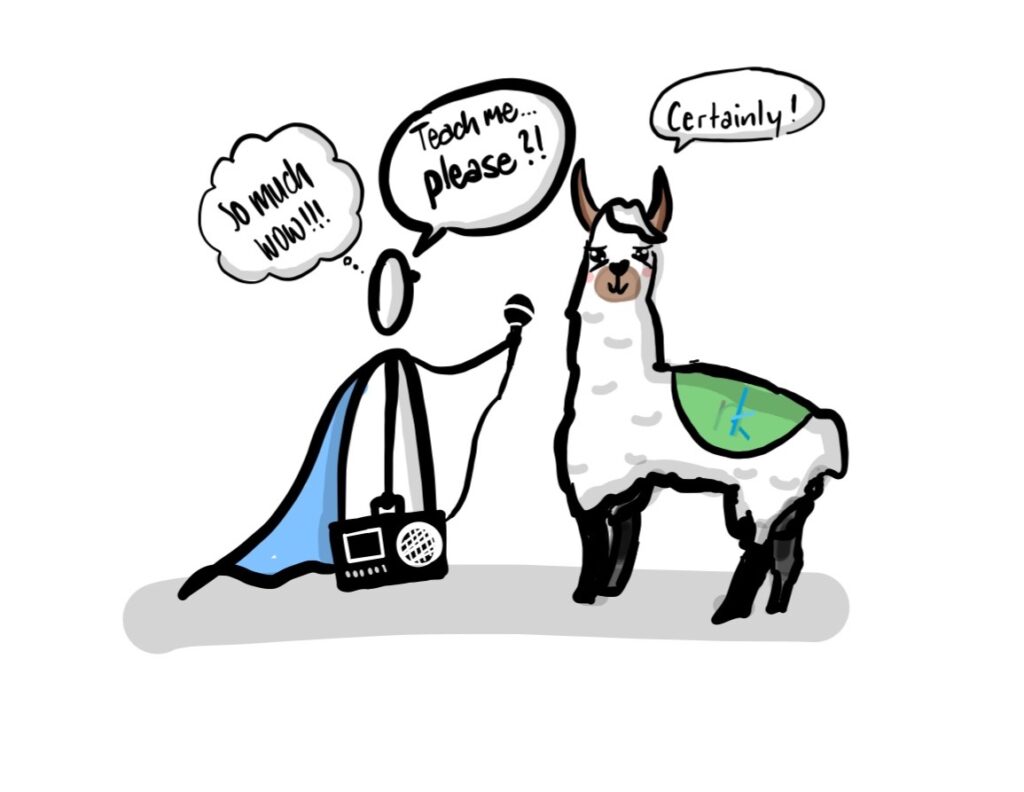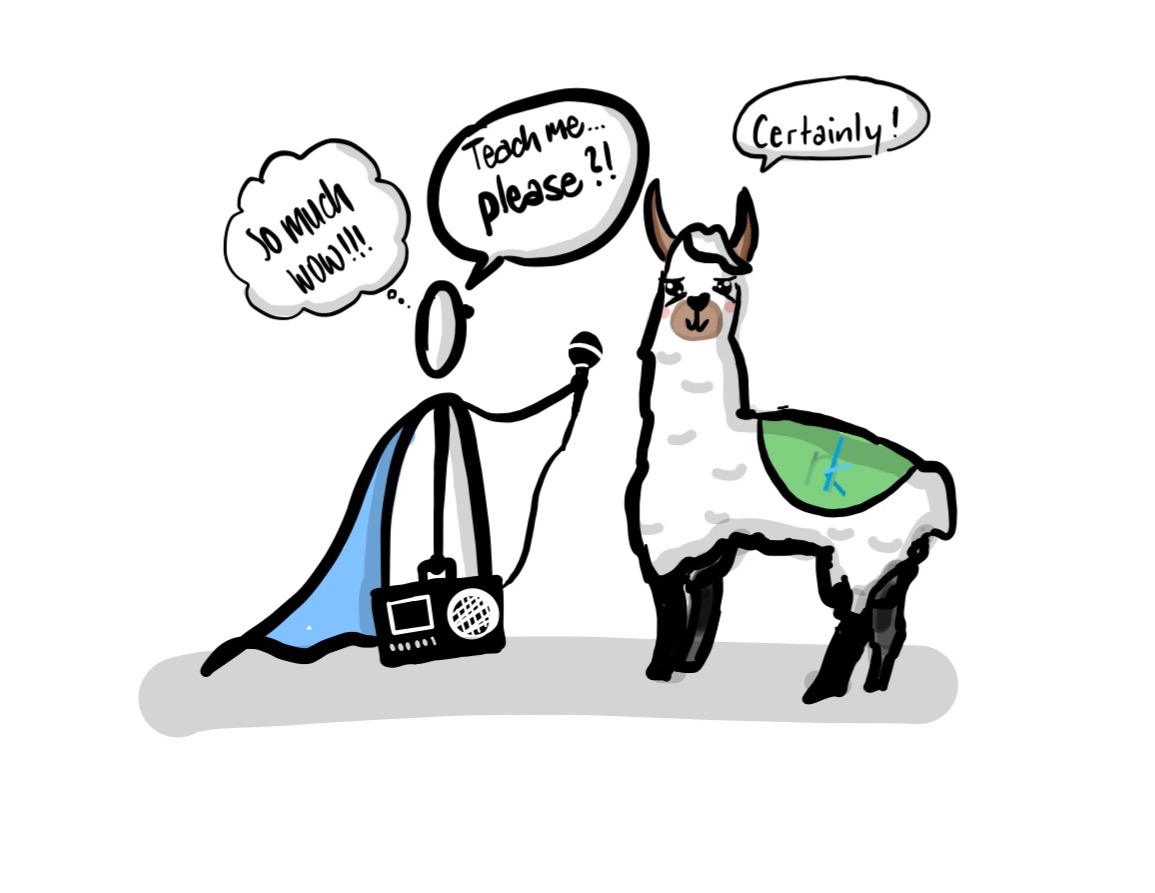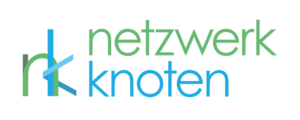
Alpacas – no need to elaborate. Social media and our hearts are overflowing with love for these furry creatures. Brown ones, white ones, furry or freshly shorn ones, big, small, tiny, sneezing (if you haven’t seen this one, you must!), dashing through the snow, wearing scarfs, wearing headphones, in nature, in stables, in hay, on meadows and of course, on the beach. Alpacas work everywhere and for everyone. The alpaca video is for our decade what the cat video was for the 2000s.
Why am I writing this article then instead of watching more videos? For months and months, I simply enjoyed the alpacas’ presence in my feed to the fullest – until one video made me take a closer look: a herd of alpacas (the beige, very furry kind with amazing haircuts) was taking an interest in a hedgehog that had entered their space. One by one they went to sniff and regard this strange occurrence, jumped away, only to go back and engage again, endlessly and as cute as ever. Now, being an agile coach, I carefully observed and have since started a list of learnings us agile coaches can directly derive from alpaca content (giving us a perfect excuse to watch more of it, you’re welcome).
Here it goes, nine things agile coaches can learn from alpacas
1. Painful curiosity.
Ever hit your nose on a hedgehog? It hurts. The alpaca from the video mentioned above agrees here. And yet, it will re-engage and not stop until its curiosity is satisfied. In my opinion, this is the perfect mindset for an agile coach: approaching the curious occurrence in question from all sides, no matter how much it hurts, because the learning will be worth the pain – and because you cannot help it, curiosity is what drives us. Also, we usually operate in contexts where other (possibly non-alpaca-mindset) humans have called on us to make things visible they themselves might not be willing or able to see, so it is literally our job to engage, even with things that kind of terrify us. How do we go about that? What can help us here is
2. Being aware of the behaviour of the group.
An alpaca that has seen a member of its herd jump away from a hedgehog will engage, but carefully. It will derive cues for its own behaviour from the behaviour it observes around itself. Same for us, especially when we are entering new contexts, new projects, new groups. Observe before you engage, it will save you possibly unnecessary pain. And when you engage and it hurts,
3. Show your feelings.
One thing I am constantly observing in myself and my colleagues, is that we are making an effort to remain as neutral and objective as possible, showing little to no involvement or reactions, being a good counselor, but one with no opinion or emotions. I want to make the case that a charming thing about alpacas is that even though they have little facial expression, one is very well aware of their state – curious, frightened, careful, freaked out – and not only does that help enjoy them, it also gives considerable amounts of orientation on how to interact with them. As agile coaches, our reactions help understand a situation. Our emotions can be the second opinion a team member needs in order to open up or that a leader needs to question a behaviour others have been bearing silently. Showing emotions and reactions openly is an advantage and shows trust and self-confidence. Of course, doing this requires strength. How do we gain that strength? By
4. Always being social.
Agile coaches are often working alone in projects or organisations. And while we sure can be effective, we too are social animals, which means we are happiest when we can be a part of a group that is just as furry as we are and can back us up, support, and understand us. This goes out to all the agile coaches skipping office days and team calls. Believe me and the happy herd of alpacas, it will make you feel better. Thus freeing you up to
5. Keep your eye on new things.
Alpacas notice immediately when things change around them. Agile coaches should too. After all, we are injected into systems in order to foster improvement via observing, establishing transparency, and introducing structures and methods that help organisations and their members feel good and effective. And how do we measure improvement? By noticing new things. And these new things might be small in the beginning and take time to grow. What helps us here is
6. Having a thick skin that can be shed if needed.
The difference between a freshly shorn alpaca and a furry one is big. Huge actually. Alpacas were made to be okay in snowy mountain ranges and grow fur accordingly. And yes, this is a metaphor. As agile coaches, we see a lot of things, hear a lot of things, bring up a lot of things, and need to be able to not let things get to us. At the same time, we need to be able to set
7. Boundaries.
It does not happen a lot, but alpacas can spit. So can agile coaches. It’s called setting boundaries and taking care of your own needs. Because as much as we are able to accommodate different systems and mindsets, we need to take care of our own resources, in a violence-free, appreciative, and positive manner of course. That also means backing up before we spit. Another way to take care of your own resources and reloading batteries is
8. Enjoyment.
Ever seen an alpaca in the snow? It jumps, it smushes, it throws itself on its back or side and rolls around in it. Same for us. Whatever there is to enjoy, we should enjoy, and publicly, making clear to the teams in our care what behaviour is desired, what learnings and improvements have been achieved and teaching by example the enjoyment of successes and the sharing of that joy. And lastly, what we can learn from alpacas is
9. Choosing to be a unicorn.
I know, there are no unicorns, at least no real ones. But! The alpaca is as close as we can get. All we need to go from alpaca to unicorn is a single horn strapped onto their forehead. And while we should never do this at home to our pet alpaca, we can understand that introducing something new and unreal, a miracle, a change, something that humans believe will never exist is just one little measure away. Let’s choose to be in a mindset of “things are possible because we are only one little change away from being a unicorn”.
Well then, fellow almost-unicorn lovers and mindset adopters, thank you for reading, feel free to go ahead to watch the sneezing alpaca video and/or share additional alpaca learnings or videos here!
And for the fellow agile coaches: next time you feel stuck, remember to mumble these words to yourself: “What would an alpaca do.…”

